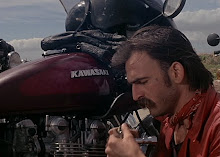This particular ailment is also known for causing wallet pain, carbon-fiber withdrawl, marriage problems, speaking in tongues and comfort issues.
No, this is not some new version of bird-flu, swine-flu or whatever flu-named-after-an-animal is attcking the globe this week. This is much worse. The bubonic plague? Ha! A mere amateur. It's much more dangerous and debilitating than that.
It's the Ducati Virus.
Once you are infected with the Ducati Virus, all hope is lost. You will never recover. You will forever be a slave to the flashy red machines that come bursting out of the small factory in Bologna, Italy.
And really, it's not a bad way to be.
Ducati is such a passionate company, it's hard not to admire them. Ducati pours everything it has into producing its motorcycles in its own unique way. Ducati's stand out-with their style, exhaust note, history and technology-against the rest of the cookie-cutter sportbikes of the world.
It's hard to believe they started out building modified bicycles.
In the twenties, the Ducati brothers (Adriano, Marcello and Bruno) started an electronics firm. While this was going on, SIATA founder Aldo Farinelli designed a small engine (50cc) that could be placed in a bicycle frame. Ducati bought these engines and created their first model, the Cucciolo, which is Italian for puppy.
Ducati's legend started to grow in the sixties when fabled designer Dr. Fabio Taglioni created the bevel-gear driven overhead cam single cyclinder engine. This engine was available in 250cc, 350cc and 450cc. In the late sxties, the 250cc Mach 1 was the fastest 250cc bike available.
These singles also were available with a new valvetrain setup born from Ducati's racing experience. The Desmondronic valve system did away with the brittle valve springs that were common at the time and replaced them with a mechanical valve system. The opening and closing of the valve was done mechanically by the camshaft. This allowed the engines to rev higher and in turn, make more power.
Besides Mach 1, the other singles had glorious names like Diana, Monza and Sebring. They also had simple flowing lines and a subtle beauty. They definitly were some of the most gorgeous motorcycles ever created.
In the early seventies, Dr. Taglioni was working on a new twin cylinder engine that would eventually become the company's trademark.
Dr. Taglioni kept the upright cylinder from the single already in production and added another cylinder jutting out of the front of the crankcase, thus creating a 90 degree V-twin. Even though this engine is a V-twin, it is often called an L-twin because of its shape. This twin was sold in varients with the Desmo valvetrain and without.
This new 750cc engine found its way into two new models: the 750GT and the 750 Sport. The GT was more of a touring machine with its large tank, two person seat and high handlebars. The Sport was an all-out race replica. It had clip-on handlebars, solo seat and rear set pegs.
The Ducati legend was cemented in the 1972 200 mile race at Imola in Italy. In the capable hands of Englishman Paul Smart and Italian Bruno Spaggiari, Ducati finished one-two, with Smart taking the win.
The most amzing part of the story was that the bikes went from the brain of Dr. Taglioni to the race track in six months. The industry norm is around three years.
This L-twin would stay in production in various models and states of tune until the early eighties, when it was replaced by the new belt driven L-twin in the Pantah models. The Ducati name and the Pantah survived the acquisition by Cagiva and the Ducati Virus was able to spread throughout the eighties. Unfortunately, around this time, Ducati's products were getting to be a little long in the tooth compared to the offerings from Japan.
The nineties saw this remedied when Ducati released the 851 Superbike. This model was a first for Ducati in many ways. It was liquid-cooled, had dual overhead cams, an aluminum frame and electronic fuel injection. Ducati went from a grandfather to a young stud overnight.
The 851 set the base for subsequent Ducati Superbikes like the 888, 916, 996 and the rare 998.
The introduction of the 999 in 2003 saw Ducati, and cheif designer Pierre Terblanche, receive much critcism over its controversial styling. However. there was no controversy over its perfromance: 0-60 in three seconds and a 170mph top speed. This was a very race-oriented machine. Any elements of comfort were nonexistant.
Today, Ducati is the largest Italian motorcycle company.
The company produces 16 models based around five versions of the L-twin. Ducati manufactures entry-level machines like the Monster to make sure people with small budgets can catch the Ducati Virus. For those with deeper pockets, Ducati offers the Superbike range with the 848, 1198, 1198S and the straight-from-the-racetrack 1198R. In between, there are retro machines, nakeds, motards and a tourer.
Like a plague of locusts, Ducati Virus has spread over all parts of the globe. Ducati has built their image on race success, beautiful designs and uncompromising performance.
All that from a bicycle.

This is where it all started. 65cc and an estimated 200mpg. Eat that, Toyota Prius!
The 250 Mach 1 was a light-weight rocket. Contemporary tests had this machine top out at 107mph.
Ducati's legend was cemented by the 750 Imola. This machine set the world on its ear and made Ducati a legitimate player in the big bike field.
The 999 was hardly what you would call "Ducatii beautiful." It was Ducati fast, however.
And the modern Ducati rocket, the 1198R Corse. Be prepared for extreme performance: 180hp, adjustable suspension and tons of MotoGP-spec parts. Expect this to be in the $40,000 range. Wow.
Images sourced from Wikipedia and Ducati.com





Great post - love the lead!
ReplyDeleteDr C